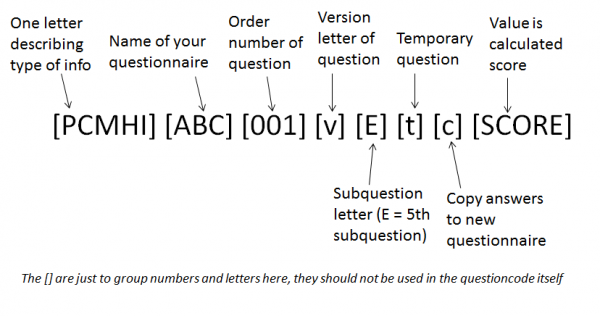Table of Contents
Code Book Lime Survey
It is important to have a systematic way of coding your questions in the different questionnaires within your Lime Survey environment. Among others, it makes analysis of data easier, you can better keep track of changes (version maintenance) and questionnaires (and their answers) can be exchanged between different installations. Below we offer a guideline that should fit the needs of most projects. However if you need to make adjustments or add something for your specific project, please do so.
Instructions for building a question code in Lime Survey
LimeSurvey does not allow for delimiters,so code is solely built up from lower and uppercase letters and numbers.
- If your question is not an ‘exception’, see list below, otherwise follow the scheme below.
- The question code starts with a capital letter for the type of information:
- P Patient or respondent characteristics excluding health status and medical history
- C Contextual characteristics of the data collection process excluding patient health status and medical history
- M Medical history, excluding baseline health status
- H Heath status over time, including baseline values
- I Intervention information
- Every questionnaire is subsequently identified with 2 to 10 capital letters, you can choose whatever letters you like as long as there are no other questionnaires with the same letters in the LS environment
- Individual questions are numbered from 001…….n.
- When a next version of the questionnaire is introduced add a lower case v after the two questionnaire letters, the next version thereafter will be vv, etc.
- When there are sub-questions add a capital letter, starting at A…..Z for first 26 sub-questions, AA, AB….. up to ZZ for the next 676 sub-questions, after the question number or version letter (if there is one)
- When you temporarily add a question then add a lower case t after the sub-question letter(s) if they exist, otherwise directly after the question number or version letter
- When you want the answer to a question being copied to another instant (round) of the same questionnaire or to another questionnaire add a lower case c after the sub-question letter(s) if they exist, otherwise directly after the question number or version letter.
- If the answer to the question is a score that is calculated from other answers add to the very end SCORE (capital letters).
As stated in rule 2 there are exceptions to question codes: Special questions have a special code, check the list below.
!! The [] are just to visually group numbers and letters here, they should not be used in the questioncode itself!!
Examples:
In which country were you born? Piq001 (Patient characteristic, questionnaire name: Intake Questionnaire, first question)
Special question codes (lower case): Variable Description age the age of the patient in years weight weight of the patient in kg height height of the patient in cm
